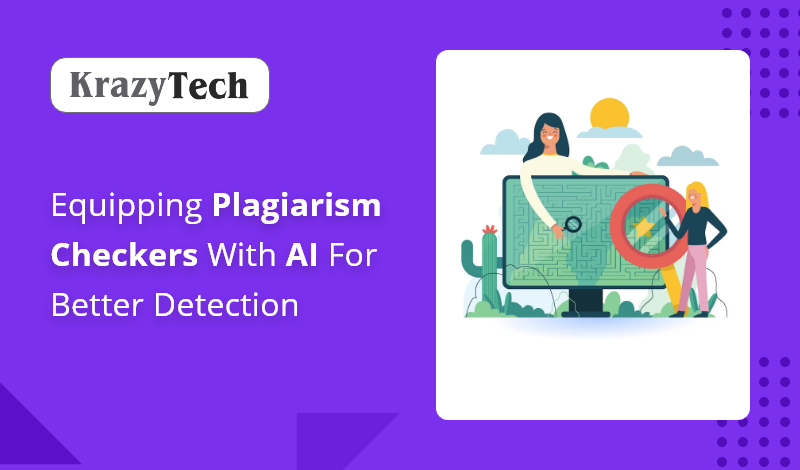After a breakthrough with Generative AI, Artificial Intelligence (AI) has made a significant impact across all technologies and industries. Gen AI helps to play with words like never before. The tools like ChatGPT have brought revolutions to content generation, content structuring, image generation, image modification, etc. Like almost every other online tool, plagiarism checkers have also been significantly improved with AI. Artificial Intelligence makes the working of plagiarism checkers a lot better and more accurate.

In this post, we’re going to be looking at how these tools generally work and how they benefit from having AI paired with them.
Let’s get started.
What are Plagiarism Checkers and How Do They Typically Work?
Plagiarism checkers are online tools that work to scan a piece of provided content and point out any plagiarism that it may contain. These tools are typically used by students and professional writers to make sure that the work they submit is unique and contains plagiarism under the tolerated limit.
Typically, plagiarism checkers are made to simply run a piece of content against a whole database of existing content, i.e., such as all the content published on all websites indexed on search engines as well as online archives of books, etc. After running the content against all this content, if there are any matching sentences or phrases, the tool highlights them.
This is the typical working of a typical plagiarism checker. Note the point that these tools only point out the exact matches.
How long does a plagiarized sentence have to be?
This is something that we deem necessary to elaborate to give you a better idea of plagiarism checkers in general.
Normally, there isn’t a particular limit as to how long a matched sentence has to be to be called plagiarized. We can’t say that if you copy six words, you’re committing plagiarism.

One of the major factors that play a role in this is the uniqueness of the matching sentence or phrase. For example, a sentence or phrase that is commonly used by everyone and anyone, e.g., “Let’s get started with this,” won’t necessarily be flagged as plagiarism.
However, if the sentence in question is unique and dedicated to a particular source, then even five or six words would amount to plagiarism. Kind of like this sentence: “The genetics experiment entailed hamster samples.”
Then again, this, too, is not a concrete rule or policy. Depending on the tool being used and the institution running the checks, the definition and criterion of plagiarism can vary.
Plagiarism Checkers | How Does AI Improve Them?
Now let’s talk about how AI improves plagiarism checkers.
Before we delve into the explanation itself, let’s do a little thing here.
Here is a sentence:
The Krakatoa eruption was one of the loudest noises ever recorded.
…and here is another sentence just like it:
The Krakatoa eruption was one of the loudest sounds ever recorded.
From what it looks like, the second sentence is just a paraphrased version of the first. While the two sentences are not exactly matching due to the single word change, it’s ethically and morally not that different from conventional plagiarism.

In plagiarism, a person takes some content and utilizes it as is. When paraphrasing unethically, a person takes some content, changes a few words, and then utilizes it. It’s equally bad.
While normal plagiarism checkers can find exact matching phrases and sentences, they can’t find paraphrased content.
This is where AI comes in.
AI basically helps plagiarism checkers to go beyond their simple functionality. It allows them to look for loosely paraphrased sentences in the provided content. If someone tries to steal content from a source by just changing a couple of words in there, you will be able to find out by using a plagiarism checker based on AI algorithms.
On this note, we should probably clarify the concept of paraphrasing a bit so that you can appreciate AI plagiarism checkers more.
What is paraphrasing, paraphrasing plagiarism, and why do you need to detect it?
We can broadly define paraphrasing as the process of rewording. When we read a piece of content and restate it in our own wording, it would be said that we’d paraphrased that particular content.
Paraphrasing itself is not a bad or unethical practice. However, it remains that way only when done properly. If it is not done properly, then it results in what we call “paraphrasing plagiarism.”
Paraphrasing plagiarism refers to the situation where a person paraphrases existing content without taking into consideration the following factors:
- Affecting enough changes so as to make the paraphrased version look very different from the original version
- In the event of not making such changes, citing the source as to relinquish ownership of the borrowed content
To sum it up in a sentence, we can put it as follows: if you have to paraphrase something, change it sufficiently, and if you can’t, then cite the source.
Suggested Read:
- Is Artificial Intelligence a Threat or a Benefit?
- Artificial Intelligence: Technology that Hosts Race between Enterprises
- Top 10 Ways Artificial Intelligence Future will Change the World
- How Can Artificial Intelligence (AI) Impact Society Negatively?
Wrapping up:
AI improves plagiarism checkers by helping them identify paraphrasing plagiarism. An AI-based plagiarism-checking tool would find out if the given content contains sentences or passages that are taken from other sources but are lightly changed to avoid getting pointed out as “plagiarized.”